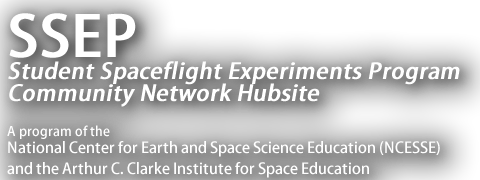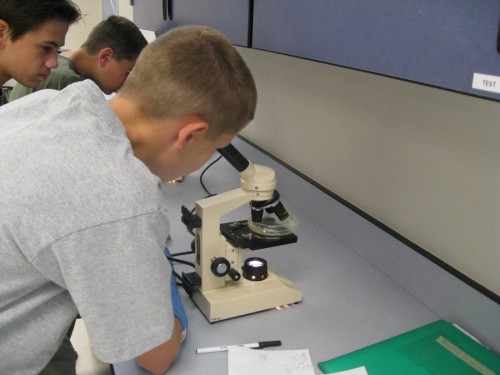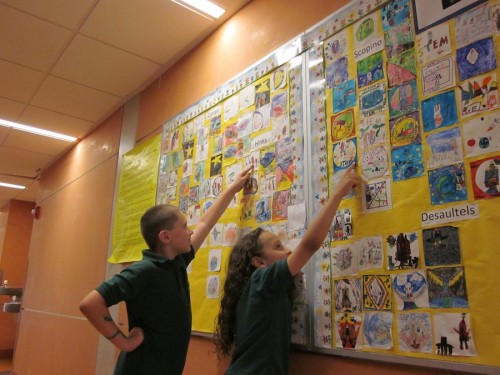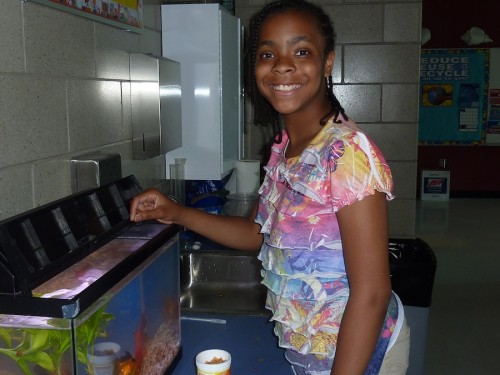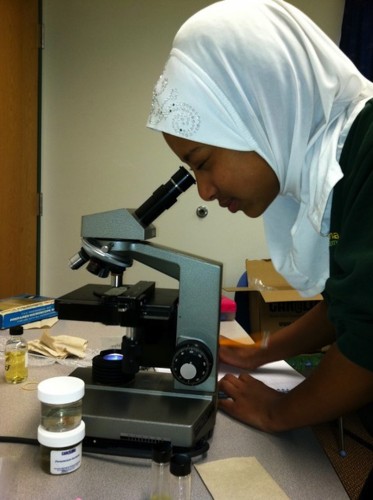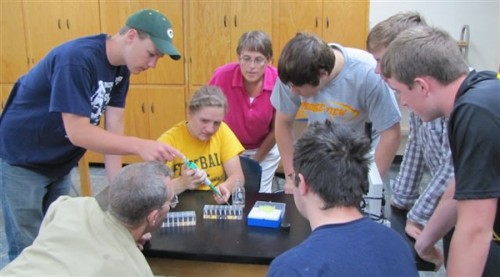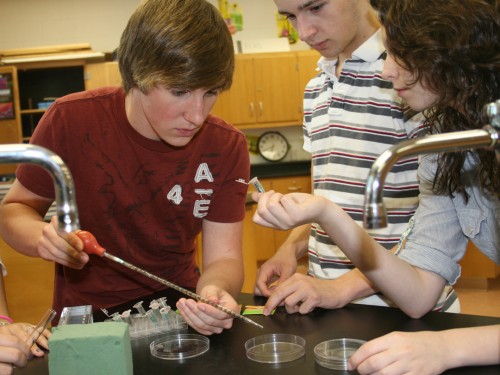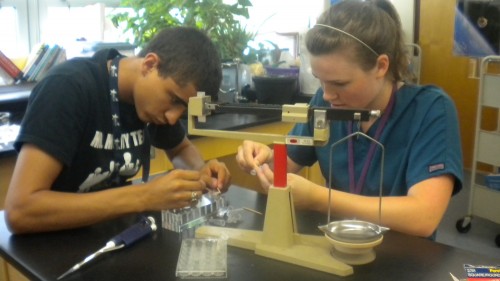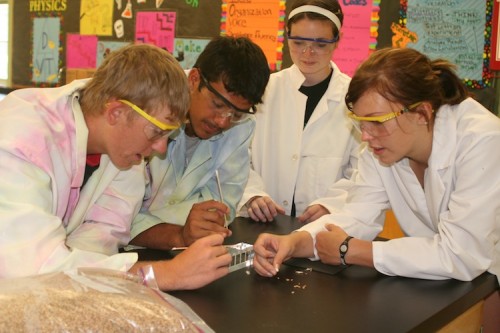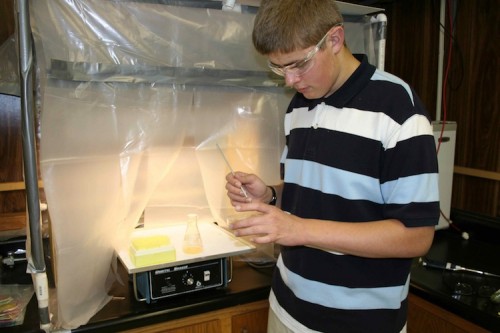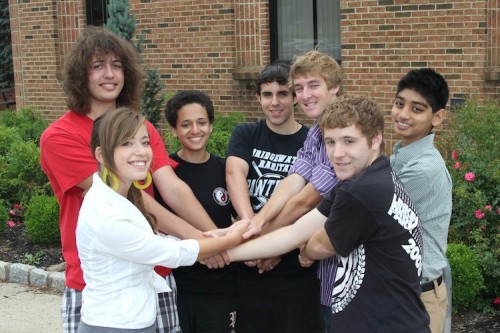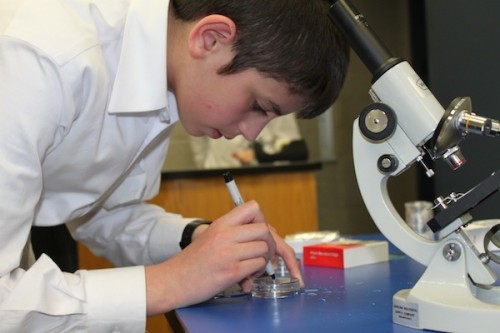The Student Spaceflight Experiments Program is proud (and stunned yet again: see STS-134 results) to report that there were a total of 530 proposals submitted from student teams across the 11 communities participating in SSEP on STS-135. Of those, 207 proposals were put forward for review by Step 1 Review Boards in each of the communities. Each Step 1 Review Board selected up to three finalist proposals, which were submitted to the National SSEP Step 2 Review Board. On May 18 and 19, 2011, the Step 2 Review Board reviewed all 31 finalist proposals, and selected one proposal to fly for each community, for a total of 11 flight experiments. Meet the SSEP Step 2 Review Board members for STS-135.
The 11 experiments will comprise the SSEP Intrepid payload (named for the Apollo 12 Lunar Module) to launch aboard the final flight of Space Shuttle Atlantis, and the final flight of the U.S. Space Shuttle Program.
This page, which lists all 31 finalist proposals, is reprinted from the May 27, 2011 SSEP National Blog Post. The Post began with a message from Dr. Jeff Goldstein, SSEP National Program Director, and NCESSE Center Director, titled: To America’s Next Generation of Scientists and Engineers Participating in SSEP on STS-135. You can read the message HERE.
Congratulations to the thousands of students and their teachers participating in the Student Spaceflight Experiments Program for the final flight of Shuttle Atlantis. Well done!
1. Peoria, Arizona
Jump to Peoria’s Community Profile
SELECTED FOR FLIGHT:
Microgravity Yeast Experiment
Grade 7, Parkridge Elementary School
Co-Principal Investigators: Jason Anderson, Devin Marispini, and Alexander Maskovich
Teacher Facilitator: Alison Thammavongsa, Science Teacher
Proposal Summary:
Our experiment will test the effect of zero gravity on yeast’s microscopic structure. Yeast rises because the yeast eats away the sugars giving off carbon dioxide bubbles and expanding the yeast. In space, we hypothesize that the yeast will have a different cell structure due to micro gravity. First we will test the experiment on Earth by using the same type of ingredients in the same kind of environment and for the same time as it will be in space. We will also assess the reaction from Earth the same way as the experiment from space. We will begin the experiment by combining honey with water. Our team will then combine yeast to the honey and water mixture. The yeast, honey, and water will initiate properly on earth, but in space we anticipate that the experiment will not work the same. Once our experiment has reached space the ingredients will be tested. In space, each ingredient will be held in the different sections of the type 2 prime well. The astronaut will gradually pull the lever that will eventually mix the honey-water mixture with the yeast. The edible chemical reaction will then expand. The microgravity will change the yeast reaction because the particles are not as compacted together as on Earth. Our motivation behind this is to find a solution to keep astronauts healthy in space by getting the grains they need. This is extremely important because if we were to find out if bread can rise in space then astronauts will be able to receive the nutrients they need. This will benefit future space missions because astronauts will be able to stay for space in longer periods of time.
HONORABLE MENTION FINALISTS:
Genetic Engineering
Grade 7, Parkridge Elementary School
Co-Investigators: Vinnie Cafarelli, Nathan Martin, Bryce Schmidt, and Michael Yonkovich
Teacher Facilitator: Alison Thammavongsa, Science Teacher
Proposal Summary:
Our group is trying to accomplish a type of genetic engineering by mixing Green Fluorescent Protein DNA Plasmids with E. coli bacteria in space. As previously tested on earth the plasmid (circular piece of DNA from a jellyfish) cannot get into the bacteria because the E. coli membrane pores are too small. The cells must be “heat shocked” so the DNA can get in. We are testing if the zero gravity affects the cell membrane allowing the plasmid to get in without heat shocking it. When foreign DNA enters bacteria, they play with the recipe, and start producing the protein. We feed the bacteria arabinose sugar and agar to “activate the switch” starting the production of the GFP protein. When the GFP is made, the cells become ampicillin resistant too. When GFP is made it glows under a black light, that’s how we know the DNA gets into the bacteria.
Space Radishes
Grade 7, Parkridge Elementary School
Co-Principal Investigators: Anjelica Martinez and Madison Witzman
Teacher Facilitator: Alison Thammavongsa, Science Teacher
Proposal Summary:
Our experiment we are conducting is to see if no gravity changes the growth in radishes. We are going to grow radishes here on earth and observe the natural development of the radishes. We want to see if growing radishes in no gravity affect the growth and ability to grow. Also we would like to see after the journey from space if it is possible to eat the vegetable here back on Earth. Since we eventually want to go to Mars then a way to do that is to grow our own radishes in space. They wouldn’t run out of food and then if we can grow them in space maybe we can grow them on Mars and that could be very helpful with people living on Mars. If these radishes after space travel are not fully grown them maybe they need to stay in space longer. We hope and believe the radishes will grow in space after their amazing adventure.
2. Hartford, Connecticut
Jump to Hartford’s Community Profile
SELECTED FOR FLIGHT:
Microgravity’s Effect on Tomato Growth
Grade 8, Annie Fisher STEM Magnet School
Principal Investigator: Ramone J. Clahar
Co-Investigators: Alonzo M. Clarke, Justice J. Dawkins, and David A. Jackson
Teacher Facilitator: Keith Sevigny, Science Teacher/Department Head
Proposal Summary:
The rationale for this outer space experimentation is to establish the effects of microgravity on the development of a tomato plant. This would be a significant topic of research because it will help astronauts to be able to have a source of food while exploring the cosmos. Currently, as astronauts go out to observe our universe, they have to stay a limited time due to their inability to obtain food while there (they have to bring a fixed food supply from Earth.) Also, tomato plants provide vitamins and minerals that are essential to human health, not to mention, they help prevent life threatening illnesses.
In this experiment, the plan is to attempt to grow tomato plants in outer space using tomato seeds, soil, and water, which will be fused together in an MDA Type 2-Prime slot of a mini-lab. It is our belief that the process that takes place in order for a tomato plant to develop on Earth will vary as it is attempted in space due to the fact that the two environments are almost opposites.
HONORABLE MENTION FINALISTS:
Sodium Chloride Crystal Growth in Microgravity
Grade 7, Annie Fisher STEM Magnet School
Principal Investigator: Andrew Classen
Co-Investigator: Kendall Crowe
Collaborator: Khalim Dyer
Teacher Facilitator: Keith Sevigny, Science Teacher/Department Head
Proposal Summary:
We want to discover how microgravity affects the crystal structure of salt, along with its characteristics. We will show how microgravity affects polymerization inside the crystal, and how the crystal actually grows. This will show how the relationship between acceleration levels, depletion zones, crystal growth rates, and crystal diffraction quality change in space. Then, after the effect on the crystal occurs, we can check the growth patterns and the type of structure built up. If the cubic build up stays the same or changes in microgravity, it can give us more information on how to perfect this type of chemical reaction. We will compare this to crystal structure grown on Earth using the same materials.
For this experiment, we will be using salt because it can be important to space travel. Salt is used in food preservation. This may prove vital for extended interstellar travel and planet exploration. If we can find out if the chemical reaction in salt can be the same on earth and space, then food preservation can be a safety used for extended space travel.
Effects of Microgravity on Bone Structure of a Brine Shrimp
Grade 8, Annie Fisher STEM Magnet School
Principal Investigator: Malcolm Bain
Co-Investigator: Kiymani Hamilton
Collaborators: Austin McIntosh and Horace Hall
Teacher Facilitator: Keith Sevigny, Science Teacher/Department Head
Proposal Summary:
The purpose of our experiment is to record the effect of microgravity on shrimp egg development. On Earth our group will keep couple shrimp eggs in two containers similar to the one on the shuttle. One will be a control group with no human growth hormone, only water and food. We will also keep a tank with the same mixture of water, food, and human growth hormone as the tube on the shuttle. We will keep track of the shrimp’s development and document their progress. When the results of the experiment is returned to Earth we will compare its results with that of the control and the and the group with the same mixture as the one that by this point will have been in space, to see if there is any change in the bone structure or density.
3. Chicago, Illinois
Jump to Chicago’s Community Profile
SELECTED FOR FLIGHT:
Will Microgravity Effect the Development of Goldfish?
Grade 5, Skinner West Classical, Fine Arts, & Technology School
Co-Principal Investigators: Eren Fitzgerald and Eric Chen
Teacher Facilitator: Kori Milroy, Science Teacher
Proposal Summary:
The purpose of this experiment is to investigate whether or not microgravity will change the development of a fertilized goldfish egg. We will collect fertilized eggs from a tank and put them in a vial with dechlorinated tap water. When the eggs come back from space, we will look at them and compare them to eggs developing on the ground. The ground experiment’s purpose is to act as a control variable. This experiment will provide insight to whether or not development will be different in space.
HONORABLE MENTION FINALISTS:
Does Metal Rust in Space?
Grade 4, Skinner West Classical, Fine Arts, & Technology School
Principal Investigator: Nadia Czekajewski
Teacher Facilitator: Kori Milroy, Science Teacher
Proposal Summary:
Does metal rust in space? I am determined to find out. I will put some metal from a paper clip into the Lower Well, leaving some room for air. I will put distilled water into the Upper Well. When the NASA astronaut turns the crank the metal and water will mix together, and after a period of time in space, we will be able to see whether metal rusts in space.
The Effect of Microgravity on Plant Life
Grade 7, Skinner West Classical, Fine Arts, & Technology School
Co-Principal Investigators: Kristel To and Amy Yip
Teacher Facilitator: Kori Milroy, Science Teacher
Proposal Summary:
We would like to know the effect of microgravity on plant life. Based on our scientific knowledge, we know that all plants need oxygen, water, and sun to grow and live. To further explore this topic, we would like to know if microgravity will affect the way that a plant will grow. In this experiment, we will use poppy seeds and sterile potting soil to aid us in our discovery. We predict that the seed should grow just like it would with the conditions on Earth, except that the experiment would attempt to grow in microgravity.
4. Avicenna Academy Science Community Collaboration (AASCC)
Crown Point, Indiana
Jump to Crown Point’s Community Profile
SELECTED FOR FLIGHT:
All Mixed Up (Based on Gause’s 1932 Experiment): The Effect of Microgravity on the Interaction of Paramecium bursaria and Paramecium caudatum in a Mixed Culture, using Yeast and Bacteria as a Food Source
Grades 4-6, Avicenna Academy (Principal Investigators and Co-Investigators); Grades 4-12, Life Learning Cooperative (Collaborators)
Co-Principal Investigators: Heba Abuzer and Jenna Rifai
Co-Investigators: Amalia Hosken, Maria Khan, Ameer Rifai, Sarah Suleiman, Sabriya Umrani, and Ayesha Zubair
Collaborators: Basil Bryson, Zoe Bryson, Gabriel Carpenter, Haley Crane, Trevor Crane, Connor Cunningham, Nicole Cunningham, Shepherd Cunningham, Rowan Everett, Christopher Martin, Erica Martin Eli Morey, Isaac Morey, Jude Morey, Sam Morey, Louie Morris, Ridge Pershing, Andy Phipps, Tressia Phipps, Josh Porch, Tonia Shirey, Jana Smith, Luke Smith, Randy Smith, Alexis Stephens, Anja Stephens, Jesse Stephens, Cameron Troy, Jennifer Viera, David Walker, and Taylor Wright
Teacher Facilitator: Amanda Arceo, M.S., M.Ed., Principal
Proposal Summary:
This experiment will be testing the effect of microgravity on the interaction of two types of paramecia: P. bursaria and P. caudatum, using yeast and bacteria as a food source. In the 1930s, a scientist named Georgyi Gause did a study on the same interaction. Gause discovered that on Earth, with gravity, both species survived. That was not the case when he tested two different species of paramecia together: P. aurelia and P. caudatum. Gause found out that the reason that both species survived is because they ate different food. Even though P. bursaria and P. caudatum both eat yeast and bacteria, when they are grown together in gravity, they chose to eat only one. P. bursaria ate yeast cells that were in the bottom of the test tube and P. caudatum ate bacteria that were floating higher up in the test tube. Both species were able to live because they did not live in the same niche, or area eating the same food supply.
HONORABLE MENTION FINALISTS:
Chive Seed Germination in Microgravity
Grades 5-11, Life Learning Cooperative (Principal Investigators and Co-Investigators); Grades 4-12, Avicenna Academy (Collaborators)
Principal Investigator: Tressia Phipps
Co-Investigators: Haley Crane and Taylor Wright
Collaborators: Heba Abuzer, Basil Bryson, Zoe Bryson, Gabriel Carpenter, Trevor Crane, Connor Cunningham, Nicole Cunningham, Shepherd Cunningham, Rowan Everett, Amalia Hosken, Maria Khan, Christopher Martin, Erica Martin, Eli Morey, Isaac Morey, Jude Morey, Sam Morey, Louie Morris, Ridge Pershing, Andy Phipps, Josh Porch, Jenna Rifai, Tonia Shirey, Jana Smith, Luke Smith, Randy Smith, Alexis Stephens, Anja Stephens, Jesse Stephens, Cameron Troy, Sabriya Umrani, Jennifer Viera, and David Walker
Teacher Facilitator: Davina (Dee) Martin, Parent Facilitator
Proposal Summary:
On June 28th the shuttle, Atlantis, will leave Earth’s orbit for a period of time between ten and 14 days. Our experiment that will be on board the Atlantis will test how plants grow in microgravity. We have selected chives or Allium Schoenoprasum as our seed to be used to investigate the growth patterns of the root systems in microgravity.
Reproduction of Yeast in Microgravity
Grade 4-6, Life Learning Cooperative (Principal Investigators and Co-Investigators), Avicenna Academy (Collaborators)
Co-Principal Investigators: Connor Cunningham and Jennifer Viera
Co-Investigators: Zoe Bryson, Rowan Everett, and Eli Morey
Collaborators: Heba Abuzer, Basil Bryson, Gabriel Carpenter, Haley Crane, Trevor Crane, Nicole Cunningham, Shepherd Cunningham, Amalia Hosken,
Maria Khan, Christopher Martin, Erica Martin, Isaac Morey, Jude Morey, Sam Morey, Louie Morris, Ridge Pershing, Andy Phipps, Tressia Phipps, Josh Porch, Jenna Rifai, Tonia Shirey, Jana Smith, Luke Smith, Randy Smith, Alexis Stephens, Anja Stephens, Jesse Stephens, Cameron Troy, Sabriya Umrani, David Walker, Taylor Wright, and Ayesha Zubair
Teacher Facilitator: Amber M. Crane, Science Teacher
Proposal Summary:
Saccharomyces cerevisiae, are unicellular fungi known as yeast. This common household item can be used as a rising agent in bread, to make alcohol through the fermentation process, and a possible deadly opportunity, like bacteria, on the human body. Yeast has a rapid reproduction cycle and is ideal for studying population growths. In this experiment, we will observe and compare total yeast populations within a closed ecosystem and the relationship they have to different environmental conditions such as microgravity. We hope to investigate if yeast will have the same reproduction processes and growth rates as the control group on Earth. Because of our study, we will perform cell counts known as “sampling” in order to estimate entire populations. The goal of the experiment is to identify growth populations of yeast that may be affected by microgravity and to understand the differences in growth populations of yeast cells in space and on Earth.
5. Galva-Holstein, Iowa
Jump to Galva-Holstein’s Community Profile
SELECTED FOR FLIGHT:
How Does Microgravity Affect the Maximum Cell Size of Tardigrades?
Grades 9-11, Ridge View High School
Principal Investigator: Dana Hustedt
Co-Investigators: Jacob Biddle, Austin Hayden, Isaac Jepsen, Gretchen Kistenmacher, Michael Perrett, and Taylor Radke
Teacher Facilitators: Art Witten, High School Chemistry and Physics Teacher, and
Patty Wheeler, High School Biology, Anatomy, and Environmental Science Teacher
Proposal Summary:
The purpose of this experiment is to see how microgravity will affect the cell size of tardigrades, commonly referred to as “water bears”. We will do this by sending up a group of tardigrades and sufficient food supply for them to feast upon. We hope to detect any significant growth difference between the microgravity specimens and earth bound specimens. Any cell size difference would support the idea of microgravity having some effect on the cells.
HONORABLE MENTION FINALISTS:
How will Microgravity Affect the Maximum Exoskeleton Size of a Cyclops?
Grades 9-11, Ridge View High School
Principal Investigator: Isaac Jepsen
Co-Investigators: Jacob Biddle, Austin Hayden, Dana Hustedt, Gretchen Kistenmacher, Michael Perrett, and Taylor Radke
Teacher Facilitators: Art Witten, High School Chemistry and Physics Teacher, and
Patty Wheeler, High School Biology, Anatomy, and Environmental Science Teacher
Proposal Summary:
We are proposing an experiment to test the effects of microgravity on the exoskeleton of a Cyclops. Cyclops is a genus of very small freshwater copepod. The exoskeleton of a Cyclops is made of chitin. In this experiment, we will send into space a sample of Cyclops along with water and zooplankton for food. The experiment will be replicated on earth at the same time. After ten days, we will measure and compare the size of the exoskeletons of the Cyclopes from outer space with those of the Cyclopes living on earth. If we measure any significant difference in size of the exoskeletons of the Cyclopes, we can conclude that microgravity does have an effect on the development of the exoskeleton of a Cyclops.
How will Microgravity Affect the Growth and Formation of Buds in Saccromyces?
Grades 9-11, Ridge View High School
Principal Investigator: Jacob Biddle
Co-Investigators: Austin Hayden, Dana Hustedt, Isaac Jepsen, Gretchen Kistenmacher, Michael Perrett, and Taylor Radke
Teacher Facilitators: Art Witten, High School Chemistry and Physics Teacher, and
Patty Wheeler, High School Biology, Anatomy, and Environmental Science Teacher
Proposal Summary:
The main objective of the experiment is to determine how a microgravity environment will affect the growth and formation of buds in Saccharomyces cerevevisae. Saccharomyces cerevevisae is a common mold species that reproduces by budding, spreading reproductive networks. Saccharomyces cerevevisae mycelia appear to form in no specific order or pattern. We will observe and compare the arrangement, size, and general structure of the space shuttle’s mold buds to that found on earth. We will observe the buds under a microscope and draw our conclusions about the patterns in which the Saccharomyces cerevevisae develop in microgravity.
6. Charles County, Maryland
Jump to Charles County’s Community Profile
SELECTED FOR FLIGHT:
Physiological effects of microgravity on germination and growth of Arabidopsis thaliana
Grades 9-12, Henry E. Lackey High School
Co-Principal Investigators: Courtney Buckman, Charles Campbell, Kristin Conyers, Devon Johnson, Chinyere McKoy-Nwachukwu, Christine Kim, Sam Paras, Sydney Scott, Paul Warren, and Deborah Cline
Teacher Facilitators: Lara North and Romulo Gabriel, Science Teachers
Proposal Summary:
The experiment detailed herein investigates the effect of microgravity on the growth of plant structures during seed germination. The team believes plant growth in a microgravity environment will result in significant changes to the majority of plant structures of the Arabidopsis thaliana model organism. The set of seeds exposed to a microgravity environment will be compared to a set of seeds grown on Earth as a control group. The comparison tool that will be used is a scanning electron microscope. The main focus of this experiment will be on the vascular tissues and the root systems of the models. However, all plant structures will be studied. A. thaliana, a small flowering plant, is widely used as a model organism in plant biology. It was the first plant to have its entire genome sequenced. If this mission is successful, individual genes of the wild type A. thaliana could then be mutated in order to determine the specific effect of microgravity on expression of individual gene sequences. Because A. thaliana has been extensively experimented with, a pattern could emerge when examining the relationship between mutated seeds germinated in space and mutated seeds germinated on Earth.
HONORABLE MENTION FINALISTS:
The Effects of Microgravity on the Cell Regenerative Properties of the Planarian Worm
Grades 6-8, Milton M. Somers Middle School
Co-Principal Investigators: Lauren Clements, T.C. Martin, and Caitie O’Donnell
Co-Investigators: Hannah Clark, Amaris Pitts, and Bethany Riege
Collaborators: Klahr Clark, Derek Noel, Simone Pitts, Haley Stewart, Marcus Stine, and Jesse Zeitler
Teacher Facilitator: Erin Beauvais, Science Teacher
Proposal Summary:
To jump-start experimental studies on cell regeneration we will test the ability of the planarian worm to regenerate cells within micro-gravity conditions. We will send the worms on the shuttle in order to test the gene a planarian worm has, which is “Smed-Prop”. “Smed-Prop” is the gene that allows the worm to regenerate body parts when cut off. For example, if you were to cut the worm in half, the head would re-grow a bottom and the bottom would re-grow a head in about twenty days. Not only does “Smed-Prop” allow the planarian worm to regenerate itself, but also allows the part to re-grow that part in the exact size and position of its previous state. Micro-gravity might have an effect on the Planarian Worm and how it regenerates itself. It possibly could have an effect on the speed of the regeneration or cause disfigurement to the Planarian Worm. The reason of interest is that in today’s society, cell regeneration is an up and coming innovation in the medical field. If we are able to prove that micro-gravity has an effect on the planarian worm specimen, we can use it in the future for human cell regeneration.
The Effect of Green Algae (Coleochaete) on Dissolved Oxygen Levels in Microgravity Conditions
Grade 8, Piccowaxen Middle School
Co-Principal Investigators: Zachary Sinclair and John Snee
Co-Investigators: Blaine Hoffman, Jake DeLozier, Ciara Albrittain, Nicole Lusk, Liam Vienneau, Austin Orth
Teacher Facilitator: Ian Buter, Science Teacher
Proposal Summary:
With future space colonization in mind, we would like to test plant life in microgravity conditions. The mixture of algae and saltwater provides for an oxygen rich environment. We would like to test a mixture of algae and saltwater on Earth while testing an identical mixture in microgravity conditions. This would provide the National Aeronautics and Space Administration (NASA) with valuable insight into future plant life in space. Health of the plant is crucial to the amount of dissolved oxygen released from the algae. If the experiment proves that algae releases more dissolved oxygen in space, a conclusion can be made that plant life is possible in space. Space colonization technology could possibly be improved if the future spacecraft transporting people would be able to produce its own oxygen using plant life. This future technology could be developed through the study of plant life in microgravity conditions. Plant life in microgravity would also reduce the amount of maintenance required for the international space station. The space station could produce its own oxygen and humans could stay on board for extended periods of time. This experiment, if proven correct, would lead to more plant life experiments in microgravity conditions.
7. Fitchburg, Massachusetts
Jump to Fitchburg’s Community Profile
SELECTED FOR FLIGHT:
The Growth Rate of Lactobacillus acidophilus in Microgravity
Grade 11, Montachusett Regional Vocational Technical High School
Co-Principal Investigators: Miguel Velez, Victoria Holbert, Kayla Nolette, and Leighton Noel
Teacher Facilitator: Paula deDiego, Chemistry Teacher
Proposal Summary:
Here on earth there is a large issue concerned with dental caries (tooth decay). The bacteria Lactobacillus acidophilus is the main cause to this issue, the bacteria combine with the proteins in the oral cavity which form a substance called plaque. Once the bacteria complete their feeding stage on the remains of food in the mouth they excrete lactic acid which dissolve the calcium and enamel on the teeth in the mouth. This process results in tooth decay.
The Lactobacillus acidophilus can be commonly found in the decayed tooth, the reason behind this is due to the fact that the outer enamel structure has been eroded away. Once the Lactobacillus settles in the dentin it accelerates the decaying process drastically. If gone untreated this could lead to the death of the nerve and blood vessels in the tooth.
We will test the growth rate of the Lactobacillus acidophilus and determine whether these bacteria reproduce at a more accelerated rate on earth or in microgravity. We will first begin by cultivating the Lactobacillus bacteria by combining the bacteria and tryptic agar (liquid) together in various concentrations. When the bacteria return from microgravity we will determine whether the bacteria reproduced more efficiently in space or on Earth.
HONORABLE MENTION FINALISTS:
HeLa Cell Growth in Microgravity
Montachusett Regional Vocational Technical High School
Co-Principal Investigators: Dominika Anna, Kaylee Nobrega, and Griffin Smith
Teacher Facilitator: Paula deDiego, Chemistry Teacher
Proposal Summary:
The experiment is focused on observing the growth of HeLa cells in microgravity. Specifically, how the growth of the cells is affected by an environment with almost no gravity in comparison to those under normal conditions on Earth. The morphology of the two cell cultures will be measured at the same period once the variable test is recovered from the shuttle. The difference between the two will determine what affect the change in gravity had on the growth of the HeLa cells.
Both the ground and flight cultures will be immersed in DMEM cell culture medium inside of a Type 2-Prime well. A solution of distilled water and fructose will be released into the sample during the experiment to support growth. This sugar will provide additional energy to the cells in conjunction with the nutrients provided by the DMEM culture medium. Both of these factors will sustain the cultures’ growth.
The purpose of the experiment is to determine what affect microgravity has on cell growth. The effects, if any, could be applied to how human bodies are affected while in space. This would provide an insight as to what could be done to protect, or strengthen, the bodies of astronauts during their missions. Another possible application of the data collected would be to determine whether it would be logical to study cell life cycles in microgravity if cells grow at an increased pace. The results of the experiment could be applied in many different ways similar to those previously stated.
Acceleration of Porphyridium Reproduction in Microgravity
Grades 10 and 12, Montachusett Regional Vocational Technical High School
Co-Principal Investigators: Benjamin Buckland, Hunter Manley, Robin Murray, and Robert Labier
Teacher Facilitator: Paula deDiego, Chemistry Teacher
Proposal Summary:
The purpose of this experiment is to determine if there is a rate difference in the growth of Porphyridium within a microgravity environment. Porphyridium is a species of red algae and it was chosen as our test subject because it contains a significant amount of protein, carbohydrates, and fatty acids. The protein and carbohydrates can be very useful as a renewable food source for astronauts possibly enabling them to be self-sufficient. The fatty acids have a potential to be used as a reproducible fuel source. We will be using type 1 because it contains one well that will express algae growth in a microgravity environment. In order to assure accuracy and precision of the experiment, we will be conducting a ground truth experiment. This is important because it will determine whether or not gravity has an effect on algae reproduction rate.
8. Potter and Dix, Nebraska
Jump to Potter and Dix’s Community Profile
SELECTED FOR FLIGHT:
Effects of Microgravity on Goodstreak Wheat
Grades 6-12, Potter-Dix Schools
Co-Principal Investigators: Josiah H., Tiffany L., and Katelyn W.
Co-Investigators: Amanda M., Coby H., and Ryley H.
Collaborators: Emmalea B., Lindsay H., Savannah M., and Thomas W.
Teacher Facilitator: Jo Wells Physics & Chemistry Teacher
Proposal Summary:
About 75 percent of grain products in the US are made from wheat. Nebraska ranks sixth in the United States for winter wheat production. The wheat chosen for this experiment is Goodstreak, a hard red winter wheat (Triticum aestivum L.), developed cooperatively by the Nebraska Agricultural Experiment Station and the USDA-ARS. The purpose of our experiment is to determine if microgravity improves Goodstreak’s germination, root development and shoot growth. Germination rate, root development and shoot growth will be recorded and compared with wheat germinated in Western Nebraska.
9. Lincoln, Nebraska
Jump to Lincoln’s Community Profile
SELECTED FOR FLIGHT:
The Effects of Microgravity on Oil Production in Salt-stressed Chlamydomonas reinhardtii
Grade 11-12, LPS Science Focus Program
Co-Principal Investigators: Kyle Chapo and Isaac Wells
Co-Investigators: Jacque Barmore, Tyler Hurley, Riley Luedtke, and Shelby Reidman
Teacher Facilitator: Mark James, Science Teacher
Proposal Summary:
Chlamydymonas reinhardtii (C. reinhardtii) responds to saline stress with an increased production of oil. The stress response to high saline is known for normal gravity but has not been studied under microgravity conditions. Does the stress response of C. reinhardtii growing in microgravity differ from the stress response of C. reinhardtii grown in normal gravity when it is stressed with 100mM saline? We will compare the oil produced in microgravity with the oil produced in an identical colony in terrestrial gravity. To compare both, we will dye them with nile red when we receive the sample back from space. This will make the lipids fluorescent, and under a microscope we can see the differences in illumination.
HONORABLE MENTION FINALISTS:
Effect of Omega-3 Fatty Acid on Liver Function
Grade 7, Scott Middle School
Principal Investigator: Akshat Saraf
Teacher Facilitator: J. Marie Hansen, Science Teacher
Mentor: Professor Srivatsan S Kidambi, Chemical and Biomolecular Engineering, University of Nebraska – Lincoln
Proposal Summary:
Due to absence of gravity in space, the function of body is affected at cell level that causes many detrimental effects such as, loss in bone and muscle mass. The astronauts also experience adverse effects in their metabolic activity. Liver is the primary gland where nutrients, medicines, even toxins are metabolized. Omega 3 fatty acid which is not made by the body has positive effect on the liver by aiding metabolism and reducing LDL. It also stimulates blood circulation; increases the breakdown of fibrin, a compound involved in clot and scar formation; and, reduces anxiety. All of these are important factor to the wellbeing of astronauts in space. In this project the effect of omega 3 fatty acid on liver tissue will be studied. The difference between earth and space environment will be compared by characterizing the structure of the cell by electron and optical microscope; activity of protein and enzyme by ELISA and Western blot analysis, and the genetic response will be studied by qRT-PCR. All the methods are available in Dr. Kadambi’s lab, the mentor for the project at the University of Nebraska. Identical conditions, such as, exposure time (10 days), temperature, sample size and chemical environment will be maintained for the space and earth experiments. If the study shows that the effect of Omega 3 fatty acid is similar to that on earth, it will help in developing supplements that astronauts can take to keep well and metabolize the medicine they take for the intended purpose.
The Effects of Microgravity on Ethanol to Eliminate Chlamydomonas Reinhardtii
Grades 11-12, LPS Science Focus Program
Co-Principal Investigators: Tyler Hurley and Rylie Luedtke
Co-Investigators: Jacque Barmore, Kyle Chapo, Shelby Reidman, and Isaac Wells
Teacher Facilitator: Mark James, Science Teacher
Proposal Summary:
The space shuttle STS-135 will contain a controlled environment with the ideal microgravity, in which we can test the effect of microgravity on ethanol and Chlamydomonas Reinhardtii (C. Reinhardtii). C. Reinhardtii can be used as an alternative fuel that can produce oil and hydrogen, and a food source. This experiment will determine what the effect of microgravity has on the ability of ethanol to kill Algae. In this experiment we will use Mederira wine “dry” as our source of ethanol because it is on the Master List of Experiment Samples and because it has a relatively high concentration of ethanol. If this experiment proves that ethanol can indeed kill C. Reinhardtii in microgravity, it can provide an alternative fuel source and a food source.
10. Bridgewater-Raritan, New Jersey
Jump to Bridgewater-Raritan’s Community Profile
SELECTED FOR FLIGHT:
Effects of Microgravity on Osteoblast Specialization and Bone Growth
Grades 11-12, Bridgewater Raritan High School
Co-Principal Investigators: Joseph Avenoso, Adam Elwood, and Rotem Herzberg
Co-Investigators: Alex Belly, Gage Cane-Wissing, and Tejas Patel
Teacher Facilitator: Jorge Valdes, Science Teacher
Teacher Mentor Team: Peter Barra, Dr. James Colaizzi, Jesse Damiano, Ariel Goebel, Lilia Klubuk, Mark Koenig and Cagan Yalama
Proposal Summary:
Our group plans to explore the possible solutions to the bone loss problem in space. After spending extended periods of time in space, the microgravity lessens the need for bone support. In an effort to be as efficient as possible the body decreases the amount of osteoblasts produced. When the astronauts return to Earth, a significant percentage of bone mass is absent and they have become physically weaker. Although they exercise daily on the spacecraft, astronauts return with much less strength. It seems that muscles are not the problem, but bones are.
The problem seems to stem from the lack of production of osteoblasts, cells that specialize into bone. Our answer to this problem is to make a more efficient osteoblast. Simply stated, the cells just have to make more bone. We plan on having one control group here on Earth while one test sample goes on the shuttle. One half vial will contain samples of mouse osteoblasts inside an agar preservative, while the other half vial contains hGH to stimulate the specialization. Studies have reported that the human Growth Hormone does affect osteoblasts in mice. When the tubes slide together the ingredients will mix and the hGH will cause bone growth in the mouse cells. Microgravity will show a difference between the space tube and the control tube. The hGH will increase the growth and specialization of osteoblasts in the test tube.
HONORABLE MENTION FINALISTS:
Crystallizing Lysozyme from Ammonium Sulfate in Microgravity Through Batch Crystallization
Grades 10, Bridgewater Raritan High School
Co-Principal Investigators: Nayan Bhat, Anish Kumar, Will Lathrop. and Amulya Yalamanchili
Teacher Facilitator: Jorge Valdes, Science Teacher
Teacher Mentor Team: Peter Barra, Dr. James Colaizzi, Jesse Damiano, Ariel Goebel, Lilia Klubuk, Mark Koenig and Cagan Yalama
Proposal Summary:
Crystallizing proteins is one of the most effective ways of determining the compound’s three-dimensional structure. Microgravity has been established as the best environment to create large, well ordered, and regular crystals. As the necessity for determining the structures of growing numbers of proteins increases, an efficient method of obtaining pure crystals is increasingly sought after. The protein lysozyme was one of the first proteins to have its structure and sequence solved. Lysozyme has been crystallized often through various methods of vapor diffusion, but has been crystallized to a lesser extent with the batch crystallization method. This method, possible in significantly smaller experiment spaces than vapor diffusion techniques, may be a more pragmatic method to easily create well-ordered crystals. To evaluate the validity of this assertion, it is necessary to develop an experiment in microgravity which utilizes batch crystallization to form crystals of a well-researched protein, such as lysozyme; the crystals formed from this experiment as well as those created from a control on Earth will be analyzed using X-ray diffraction, and compared to the established structure of lysozyme proteins.
A Review of Statoliths and the Effects of Gravity on Root Cells
Co-Principal Investigators: Katherine Caola, Sara Lyons, and Jennifer Wachtel
Collaborators: James Conlon
Teacher Facilitator: Cheryl Pieroni, Biology Teacher
Teacher Mentor Team: Peter Barra, Dr. James Colaizzi, Jesse Damiano, Ariel Goebel, Lilia Klubuk, Mark Koenig and Cagan Yalama
Proposal Summary:
This experiment aims to discover how the roots of plants deal with micro-gravity conditions. A pre-germinated Rutgers Tomato seed will be used to study how statoliths, a gravity-detecting organelle in a plant root cell, react to changes in gravity. Rutgers tomatoes have particularly long roots which would clearly demonstrate the direction of root growth in a microgravity environment. In each root cell, the statolith adjusts to changes in gravity. The root cells detect the position of the statolith as a signal for direction of growth. Normally this results in gravitropism, but in microgravity conditions these effects would be altered. This experiment will utilize a Type II well design with the pre-germinated seed and other materials to help it stay alive in one well, and a fixative in the other. Once the experiment is in space, the statoliths in the root cells will immediately begin to shift in response to the change in gravity. Once the fixative is engaged, the statoliths will be prevented from moving during re-entry and transportation. The results of this experiment will help us predict how a whole plant will react to microgravity conditions, and could have major implications for the possibility of growing food in space, possibly enabling a successful manned mission to Mars, extended missions to the moon, or other exploratory programs in the future that require humans to travel greater distances for long periods in outer space.
11. Yeshiva Ketana of Long Island, Inwood, New York
Jump to Inwood’s Community Profile
SELECTED FOR FLIGHT:
Deposition and Formation of Zinc Phosphate Crystals in Microgravity
Grades 6-7, Yeshiva Ketana of Long Island
Principal Investigator: Rami Alter
Co-Investigators: Yonasan Brody and Dovid Wurtzberger
Collaborators: Shmuel Aidelson, Ari Englander, and Dovi Schlossberg
Teacher Facilitator: Larissa Steele, Assistant Principal
Proposal Summary:
In this experiment, we will investigate the reaction of sodium phosphate with zinc chloride to produce sodium chloride and a precipitate of zinc phosphate. Since the reaction will be in aqueous solution, the precipitate should form hopeite crystals. The aqueous solutions will begin in separate sections of the Type 2-Prime well that will combine while in orbit.
Zinc phosphate is used on metal surfaces to reduce corrosion and can be used in dental cement. Crystals grown in microgravity tend to have fewer defects than those grown in laboratories on earth. Understanding the purer form of zinc phosphate’s structure may provide useful information for commercial and industrial applications requiring anti-corrosion coatings or in the medical sciences, such as dentistry.
We will compare the crystals grown in microgravity with our controls grown in our science lab to see which are more perfect. The director of the X-Ray Diffraction Facility at CUNY, Dr. Louis J. Todaro, will analyze the sample and explain the results to us. We will use a light microscope with a magnification of at least 40x to investigate the general shape and structure of the crystals. We will measure the mass of the precipitate and provide observations on where the crystals form, such as if a thin film forms between the two chambers of the Type 2-Prime well, on the well walls, or as a suspension which settles to the bottom of the well after returning to earth.
HONORABLE MENTION FINALISTS:
Effects of Microgravity on Growth of Brassica juncea Planted in Different Soil Substitutes
Grades 5, Yeshiva Ketana of Long Island
Co-Principal Investigators: Shimon Katz and Daniel Yehuda Molinsky
Co-Investigator: Eitan Carrol
Collaborators: Ami Birnbaum and Yehuda Feinberg
Teacher Facilitator: Larissa Steele, Assistant Principal
Proposal Summary:
Assessing rates of plant growth in different soil substitutes in microgravity can be used to determine what substrates are most conducive to plant growth. This knowledge will help future space expeditions grow plants in the most effective way to produce food or to use as carbon dioxide sinks.
We investigate the growth in microgravity of Brassica juncea, a mustard plant, in different soil substrates. In a Type 1 well, one set of three seeds will be grown in OASIS substrate and three other seeds will be grown in cotton. Each side will be moistened with a small amount of glucose solution. To prevent mixing of substrates or solutions, each side will be separated by a thin layer of silly putty.
Growth of the seeds will be compared across the substrates in microgravity and between the space and control conditions. The control conditions on earth will mimic the space conditions. The seeds will be grown in an incubator. The total length, apparent stage of germination, and total mass of the seedlings will be compared across all samples and across all soil types. Upon returning to earth, the mustard seeds will be transplanted into to a larger well containing the same type of substrate and glucose solution. Their continued growth on earth will be observed during the next two weeks and observations of attained height will be compiled.
Regeneration of Planaria in Microgravity Cut Along Plane Perpendicular to Anteroposterior Axis
Grades 5 and 7, Yeshiva Ketana of Long Island
Co-Principal Investigators: Chaim Feller and Zecharia Steele
Co-Investigators: Avi Greenberg and Nata Shalom Edell
Collaborators: Yaakov Eisig, Rafi Levine, and Yitzy Black
Teacher Facilitator: Larissa Steele, Assistant Principal
Proposal Summary:
Planaria are known for their ability to regenerate lost tissue. Understanding neoblasts, stem cells that spearhead the regenerative process, may provide insight into tissue regeneration. Aside from using the research in the medical field, basic research into regeneration could provide insight into the aging process. This may allow rejuvenation therapy.
This experiment investigates the capacity of planaria forced to regenerate in microgravity to regenerate a second time once returned to earth. We will ensure genetically identical planaria by cutting a single planaria into multiple pieces and then regrowing each piece. Six identical planaria will be cut midway along the anteroposterior axis to separate the head from the tail. Three heads and three tails will go into space. The other set will be used for our control group.
It takes several days for planaria to regenerate missing tissue. We will use light microscopes with 40x magnification to observe any differences between the planaria that regenerate in microgravity and those that regenerate on earth. The ability of the planaria sent into space to regenerate a second time while on earth may be influenced by their initial stay in microgravity. We will cut the planaria again to separate the heads from the tails. We will determine the length of the second regenerative cycle by observing video footage of both sets of planaria as they regrow on earth. This will be compared to our control group.
